 Svenska: |
Glamsten
Högt över den lilla byn Stuv i Kungsbacka kommun tronar Hallands största flyttblock, Glamsten.
Flyttblock har i alla tider fascinerat oss, vilket gjort dem mytomspunna med berättelser om troll och jättar. Oftast handlar det om jättar som störs av kyrkklockornas klang och kastar dessa stora stenar för att få tyst på dem. Men om just Glamsten finns det väldigt lite skrivet.
Flyttblock (erratiskt block)
Ett flyttblock, eller erratiskt block som det heter på geologispråk, är ett stenblock som slitits loss från sitt ursprungsberg och transporterats iväg av stora isar.
Flyttblocken har flyttats med hjälp av inlandsisar eller glaciärer. De flyttas i isens rörelseriktning, och då isen sedan smälter sjunker blocken till botten. Flyttblock kan också ha transporterats i kringflytande isberg och därför ha hamnat långt ifrån sina ursprungliga områden. De svenska flyttblock bestär därför framförallt av magmatiska och metamorfa bergarter som granit och gnejs från vårt eget urberg.
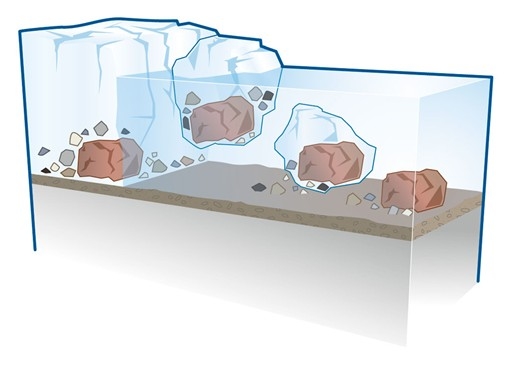
En långväga gäst…
"Der Alte Schwede" (GC1M15Z) heter ett flyttblock som hittades 1999 vid muddringsarbeten i floden Elbe som rinner genom Hamburg. Flyttblockets omkrets är 19,7 meter, och dess höjd är 4,5 meter. "Der Alte Schwede” väger imponerande 217 ton och har förts drygt 500 km från Småland till Hamburg av inlandsisen drygt för ca 400 000 år sedan, alltså under någon av istiderna Elster eller Cromer.
Med isen som budbärare...
De flyttblock som vi återfinner i Sverige idag kommer från vår senaste istid, som inleddes för ca 115000 år sedan. Men det var omkring 20000 f. Kr. som den nådde sin största utbredning och täckte hela den skandinaviska halvön, hela Baltikum och nästan hela Danmark. Det sammanhängande istäcket nådde en bit ner på kontinenten, ungefär till floden Wisla i Polen. Eftersom isen kom från norr och drog sig tillbaka dit, har samtliga flyttblock i Sverige sina ursprungsområden norr om var de ligger. Många av de som påträffas i Roslagen, norr om Stockholm, består av röd sandsten från Gävletrakten. De har med andra ord flyttats omkring 15 mil.
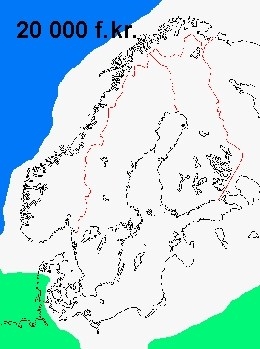
Ungefär 14000 f. Kr släppte isen sitt grepp om kontinenten och nu var det bara den skandinaviska halvön och delar av Baltikum som var täckt. Detta var strax före den varma Bölling-perioden 13000 - 12200 f. Kr. då isen smälte bort från Skåne, Blekinge, Halland och större delen av Småland. Issmältningen bidrog inte bara till att stora stenblock flyttas långa sträckor, bl.a. skapades även under denna tid våra rullstensåsar, drumliner (GC29FPW) och all den morän (GCQJ0M) som täcker ca 75% av vårt avlånga land.
Den sista köldknäppen inträffade ca 10200 f. Kr. Glaciären skulle från och med nu enbart dra sig tillbaka. Klimatet utgjordes av tundra och det som ska bli Östersjön kallas för Baltiska issjön. För ungefär 11500 år sedan (ca 9500 f. Kr) höjdes temperaturen drastiskt och glaciärisens avsmältning accelererade. Nu började Halland se dagens ljus och det är från den här tiden som de flesta flyttblocken i landskapet härstammar. Ett svagt inflöde av saltvatten gör att Baltiska issjön förvandlas till Yoldiahavet.
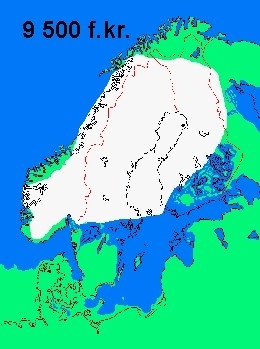
Ungefär 8500 f. kr ligger medeltemperaturen på en nutida nivå och därmed är istiden officiellt över. Landhöjningen har gjorde att Östersjön återigen blev en insjö som nu kallas för Ancylussjön. De sista resterna av glaciärisen smälte bort under det följande årtusendet.
För ca 7500 år sedan gjorde landssänkningen i södra delarna av den skandinaviska halvön att saltvatten trängde in i Ancylussjön som nu förvandlas till Litorinahavet. Medeltemperaturen som fortsatt att öka är vid den här tiden 2-3 grader högre än idag.
Flyttblock i folktron
Flyttblock är inom folktron ofta förknippade med övernaturliga väsen, som t.ex. Trollastenen (GC1YH43) norr om Trolle-Ljungby i Skåne.
När folk förr i tiden fann flyttblock trodde de att det var jättar som hade slungat iväg ett stort stycke berg, därför låg de spridda i landskapet. Därför kallades stenblocken för jättekast. Man trodde framförallt att jättar blev rasande på kyrkornas klockklang. I ren ilska kastade de block mot närmaste sockenkyrka för ljudet av klockorna gjorde så hiskeligt ont i deras öron.
Flyttblock hittas ofta intill just kyrkor runt om i Sverige. Frågan är väl bara vad som kom först…
Andra flyttblock i Halland, värda att besöka:
 Glomstenen (GC23552)
Glomstenen (GC23552)
 Slyngestenen (GC24JJV)
Slyngestenen (GC24JJV)
 KnystaHall (GC2ZBZ6)
KnystaHall (GC2ZBZ6)
Att logga Earthcache Glamsten:
För att logga denna Earthcache måste du besvara följande frågor:
1. Hur ser man skillnad på granit och gnejs?
2. I Sverige har varje landskap en landskapssten. Vilken är Hallands landskapssten?
3. Glamsten har transporterats hit vid den senaste istiden. Vad kallas den?
4. Mät Glamstens höjd och bredd för att kunna approximera dess radie. Beräkna sedan blockets vikt.
Tips: Betrakta stenblocket som ett klot med densiteten 2,68 ton/m³ (densiteten på hallandsgnejs).
Bifoga gärna en bild på dig själv och/eller din GPS vid flyttblocket till din logg.
Svaren skickar du i ett mail till cacheägaren, din uträkning för fråga 4 måste redovisas.
Du får logga först efter godkännande från cacheägaren.
Redovisa inga svar i din log
Happy caching!
Ludde Lump
 English: |
Glamsten
High above the small village of Stuv in Kungsbacka Municipality enthroned Halland's greatest boulders, Glamsten.
Boulders has always fascinated us, which made them legendary with tales of trolls and giants. Usually it's about giants who are disturbed by the ringing of the church bells and throws these big rocks to silence them. But there is very little written about Glamsten.
Boulders (glacial erratic)
A boulder or glacial erratic as it is called in geology, is a rock torn from its original mountain and carried away by glacial ice.
Boulders have been moved by glacial ice or glaciers. They are moved in the direction of movement of the ice, and when the ice melts the blocks drops to the bottom. Boulders can also be transported in floating icebergs and thus have ended up far from their original areas. The Swedish boulder consists therefore mainly of igneous rocks and metamorphic rocks such as granite and gneiss from our own bedrock.

A guest long way from home...
"Der Alte Schwede" (GC1M15Z) is a boulder found in 1999 at the dredging of the river Elbe in Hamburg, Germany. The circumference of the bolder is 19,7 meters (55,77 feet), and its height is 4,5 meters (13.12 feet). "Der Alte Schwede" weighs an impressive 217 tonnes and has been moved over 500 km from Småland in Sweden to Hamburg in Germany by the ice sheet for about 400 000 years ago, during any of the ice ages Elster or Cromer.
The ice as a messenger ...
The boulders that we find in Sweden today comes from our last ice age, which began about 115,000 years ago. But it was around 20,000 BC. as it reached its greatest extent, covering the entire Scandinavian peninsula, the Baltic countries and almost all of Denmark. The continuous ice cover reached a bit down on the continent, much of the River Vistula in Poland. Since the ice came from the north and retreated there, all the boulders in Sweden have their home areas to the north of where they are located. Many of the boulders found in Roslagen, north of Stockholm, is composed of red sandstone from the Gävle region. In other words have they been moved about 150 km (93,2 miles).
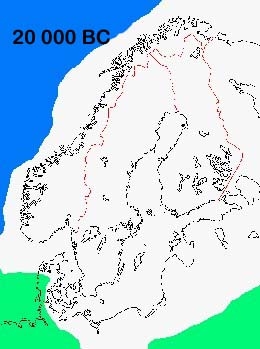
Approximately 14,000 BC the ice released its grip on the continent and now it was only the Scandinavian peninsula and parts of the Baltic states that were covered. This was just before the warm Bolling period 13,000 - 12,200 BC. when the ice melted away from Skåne, Blekinge, Halland and most of Småland. The melting ice didn’t only contributed that large boulders were moved long distances, including created during this time the eskers, drumlins (GC29FPW) and all of the moraine (GCQJ0M) which covers about 75% of our country.
The last cold clasps occurred around 10,200 BC. The glacier would from now on only to withdraw. The climate consisted of tundra and what will be the Baltic Sea is called the Baltic ice lake. For about 11,500 years ago (about 9,500 BC) the temperature rose drastically and glacial ice melting accelerated. Now Halland appears and it is from this period that most boulders in the landscape originated. A weak flow of salt water makes the Baltic ice lake turns into Yoldia Sea.
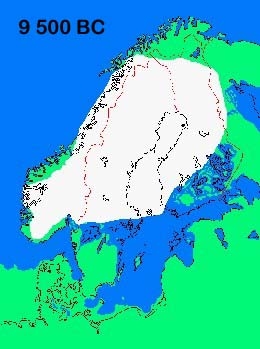
Around 8500 BC, the mean temperature at a contemporary level and the ice age is officially over. Uplift has led to the Baltic again became a lake, now called the Ancylus. The last remnants of glacial ice melted during the next millennium.
For about 7500 years ago the country fall in the southern parts of the Scandinavian peninsula and saltwater penetrated the Ancylus and now turns it into Litorina Sea. The average temperature as continued to increase, at this time 2-3 degrees centigrade higher than today.
Boulder in folklore
Boulder is in folklore often associated with supernatural beings, such as Trollastenen (GC1YH43) north of Trolle Ljungby in Skåne.
When people in the past found the boulder they thought it was the Giants who had thrown a big hunk of rock, that’s why they were scattered in the landscape. Therefore they are called “jättekast” (giant throwes). It was believed that the giants became enraged at church bells. In pure rage they therefore threw the blocks to the nearest church to silent the sound of bells, which horribly hurted their ears.
Boulders are often found next to the great churches around Sweden. The question is just what came first ...
Other boulders in Halland, worth visiting:
 Glomstenen (GC23552)
Glomstenen (GC23552)
 Slyngestenen (GC24JJV)
Slyngestenen (GC24JJV)
 KnystaHall (GC2ZBZ6)
KnystaHall (GC2ZBZ6)
Logging Earth Cache Glamsten:
To log this Earthcache, you must answer the following questions:
1. How can you see a difference between granite and gneiss?
2. In Sweden, every landscape has it own landscape stone. What is the landscape stone of Halland?
3. Glamsten was transported here by the last ice age. What is it called?
4. Measure Glamsten's height and width in order to approximate its radius. Then calculate the block's weight.
Tip: Consider the rock as a sphere with a density of 2.68 t / m³ (the density of hallandsgneiss).
If you want to, please include a picture of yourself and / or your GPS at the boulder to your log.
Send your answers in an email to the cache owner, your calculations for question #4 must be reported.
You may sign the Earthcache only after approval by the cache owner.
Don't report any answers in your log!
Happy caching!
Ludde Lump